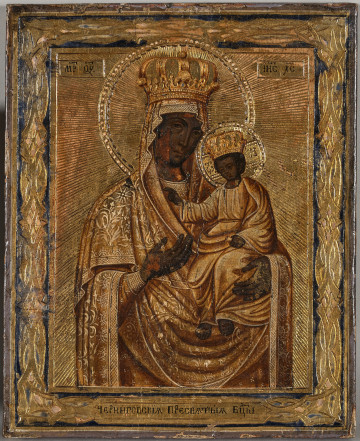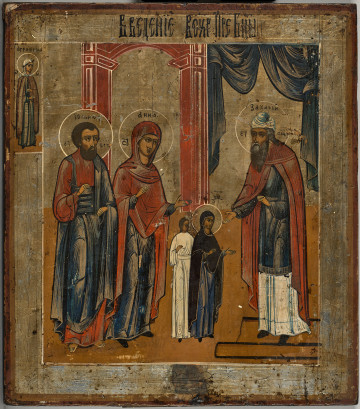
The Mother of God of Hodigitria
19th (?) century
Castle Museum in Łańcut
Part of the collection: Ikony
Objects of worship cast from metal alloys were initially brought to Rus from Byzantium. Locally crafted objects modelled after their Byzantine predecessors appeared in the 11th c. and became widespread in the 12th-13th c. They were produced in Kievan Rus. After the fall of Kiev, caused by the Mongol invasion in the middle of the 13th c., casting of various metal crosses and icons developed in the north. Veliky Novgorod became the leading centre of casting; there, such objects were traditionally cast in bronze with high copper content, using stone or clay moulds. Rus developed its own style, different from the Byzantine models; subdued figures with disproportionately large heads were usually depicted frontally. The presented icon in the form of a plaque, cast with a hook for hanging, is one of such northern Rus crafts. The face of the painting, divided into twelve fields arranged in three horizontal rows, shows: on the pendant - a depiction of Christ's face known as 'not created with human hands', as well as the most important feasts of the liturgical year: Annunciation of the Mother of God, Nativity of Jesus, Entry of the Mother of God into the Temple, Presentation of the Lord at the Temple (top row); Entry of Christ into Jerusalem, the Crucifixion, the Harrowing of Hell, Ascension of Christ (middle row); Resurrection of Lazarus, Descent of the Holy Spirit, Dormition of the Mother of God, Transfiguration of Christ (bottom row). All the scenes are described in Cyrillic. Since the annexation of Novogrod to the Grand Duchy of Moscow in the 15th c., Moscow became the principal centre of casting. Since the 17th c., cast metal objects of worship were produced on the river Vyg by the persecuted in Russia Old Believers, who did not accept the liturgical reform. They developed their own forms of casting, including folding icons depicting feasts, see S.12780MŁ, S.12860MŁ, S.12861MŁ. Teresa Bagińska-Żurawska https://orcid.org/0000-0002-9243-3967
Dimensions
height: 7 cm, width: 5 cm
Object type
Icons
Technique
metallurgical
Material
bronze
Origin / acquisition method
zakup
Creation time / dating
Creation / finding place
Owner
Castle Museum in Łańcut
Identification number
Location / status

19th (?) century
Castle Museum in Łańcut

1800 — 1850
Castle Museum in Łańcut

1800 — 1899
Castle Museum in Łańcut
DISCOVER this TOPIC
National Museum in Szczecin
DISCOVER this PATH
Educational path